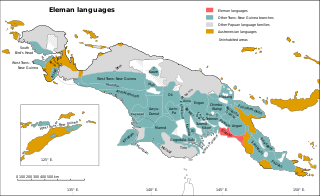Related Research Articles
Ethnologue: Languages of the World is an annual reference publication in print and online that provides statistics and other information on the living languages of the world. It is the world's most comprehensive catalogue of languages. It was first issued in 1951, and is now published by SIL International, an American evangelical Christian non-profit organization.

The Torricelli languages are a family of about fifty languages of the northern Papua New Guinea coast, spoken by about 80,000 people. They are named after the Torricelli Mountains. The most populous and best known Torricelli language is Arapesh, with about 30,000 speakers.
The Lower Mamberamo languages are a recently proposed language family linking two languages spoken along the northern coast of Papua province, Indonesia, near the mouth of the Mamberamo River. They have various been classified either as heavily Papuanized Austronesian languages belonging to the SHWNG branch, or as Papuan languages that had undergone heavy Austronesian influence. Glottolog 3.4 classifies Lower Mamberamo as Austronesian, while Donohue classifies it as Papuan. Kamholz (2014) classifies Warembori and Yoke each as coordinate primary subgroups of the South Halmahera–West New Guinea languages.

The South Bougainville or East Bougainville languages are a small language family spoken on the island of Bougainville in Papua New Guinea. They were classified as East Papuan languages by Stephen Wurm, but this does not now seem tenable, and was abandoned in Ethnologue (2009).
The East New Britain languages are a possible small language family spoken on the Gazelle Peninsula of New Britain in Papua New Guinea. They were classified as East Papuan languages by Wurm, but this does not now seem tenable. The only comparative work that has been done between the two branches of the proposed family is Ross (2001), which shows similarities in the pronouns.
The Dani or Baliem Valley languages are a family of clearly related Trans–New Guinea languages spoken by the Dani and related peoples in the Baliem Valley in the Highland Papua, Indonesia. Foley (2003) considers their Trans–New Guinea language group status to be established. They may be most closely related to the languages of Paniai Lakes, but this is not yet clear. Capell (1962) had posited that their closest relatives were the Kwerba languages, which Ross (2005) rejects.

The Eleman languages are a family spoken around Kerema Bay, Papua New Guinea.

The Angan or Kratke Range languages are a family of the Trans–New Guinea languages in the classification of Malcolm Ross. The Angan languages are clearly valid as a family. They were first identified as such by J. Lloyd and A. Healey in 1968; Wurm (1975) classified them as Trans–New Guinea. Glottolog treats Angan as a separate or unclassified family, ignoring further evidence.

The Duna–Pogaya (Duna–Bogaia) languages are a proposed small family of Trans–New Guinea languages in the classification of Voorhoeve (1975), Ross (2005) and Usher (2018), consisting of two languages, Duna and Bogaya, which in turn form a branch of the larger Trans–New Guinea family. Glottolog, which is based largely on Usher, however finds the connections between the two languages to be tenuous, and the connection to TNG unconvincing.

The Sepik Hill languages form the largest and most ramified branch of the Sepik languages of northern Papua New Guinea. They are spoken along the southern margin of the Sepik floodplain in the foothills of Central Range of south-central East Sepik Province.

The Pahoturi River languages are a small family of Papuan languages spoken around the Pahoturi. This family includes eight language varieties including Agöb (Dabu), Em, Ende, Idan, Idi, Idzuwe, Kawam, and Taeme, which are spoken in the Pahoturi River area south of the Fly River, just west of the Eastern Trans-Fly languages. Idzuwe is no longer spoken. Ross (2005) tentatively includes them in the proposed Trans-Fly – Bulaka River family, though more recent work has classified Pahoturi River as an independent family within the region.
The Walio languages are a small family of clearly related languages,
Mpur is a language isolate spoken in and around Mpur and Amberbaken Districts in Tambrauw Regency of the Bird's Head Peninsula, New Guinea. It is not closely related to any other language, and though Ross (2005) tentatively assigned it to the West Papuan languages, based on similarities in pronouns, Palmer (2018), Ethnologue, and Glottolog list it as a language isolate.
Hatam is a divergent language spoken on the island of New Guinea, specifically in the Indonesian province of West Papua.
Abun, also known as Yimbun, Anden, Manif, or Karon Pantai, is a Papuan language spoken by the Abun people along the northern coast of the Bird's Head Peninsula in Sausapor District, Tambrauw Regency. It is not closely related to any other language, and though Ross (2005) assigned it to the West Papuan family, based on similarities in pronouns, Palmer (2018), Ethnologue, and Glottolog list it as a language isolate.
Omati, or Mini, is a Papuan language spoken in the Omati River area of Papua New Guinea. The two varieties, Barikewa and Mouwase, are quite divergent.
Grand Valley Dani, or simply Dani, is one of the most populous Papuan languages in Indonesian New Guinea. The Dani people live in the Baliem Valley of the Western Highlands.
Glottolog is a bibliographic database of the world's lesser-known languages, developed and maintained first at the Max Planck Institute for Evolutionary Anthropology in Leipzig, Germany. Its main curators include Harald Hammarström and Martin Haspelmath.
Hatam–Mansim is a small language family of Western New Guinea, consisting of two languages:
Densar is a poorly attested Bayono–Awbono language spoken in the highlands of Papua Province, Indonesia. Glottolog tentatively groups it with Awbono.
References
- ↑ Hupla at Ethnologue (25th ed., 2022)

- ↑ "Glottolog 4.8 - Hupla". glottolog.org. Retrieved 2023-10-26.
- ↑ MAFADMIN (2013-09-07). "L'arrivée par avion de la Bible traduite en langue Hupla". MAF France (in French). Retrieved 2023-10-26.